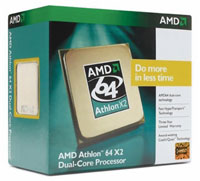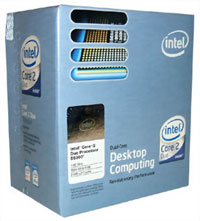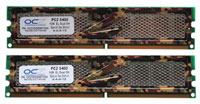Basic Midrange Configurations
We'll start with the Intel and AMD options for what we consider a basic midrange computer. These will offer good performance for a variety of tasks, but they are not tailored towards anything in particular. Before we get into the actual component lists, let's take a moment to clarify a few things. First, a lot of people certainly don't need all of the options we are listing below. Dual core processors are faster for some tasks, but there are still plenty of applications that run perfectly well on older systems, and they certainly don't need the processing power offered by a dual core CPU. Not everyone needs 2GB of memory, a discrete graphics card, a relatively large hard drive, etc. However, we are building what we consider to be a good all-around computer, and individualization can still be beneficial. If you're looking to cut costs a bit further, you can find additional information and advice in our last
Entry Level Buyer's Guide.
A second topic that we need to address is the question of AMD Athlon X2 versus Intel Core 2 Duo processors. If performance is your primary consideration, there are very few areas where Core 2 Duo isn't faster. Once you reach the Core 2 Duo E6600, it becomes faster than just about any official AMD Athlon X2 processor in overall performance, and the only way you will surpass its performance is with overclocking. When you start overclocking both platforms, however, Core 2 Duo is basically out of reach of AMD's current processor line. So Core 2 Duo is the way to go, right?
In actuality, AMD has done what most companies do when their product does not offer best in class performance: they cut prices, sometimes quite drastically. Motherboards for AMD systems also tend to be a bit less expensive than their Intel counterparts. The net result is that while Intel is undoubtedly the faster processor overall, AMD is very competitive - and perhaps even better - when it comes to price/performance. That goes double if you plan on getting a single core processor, as Intel doesn't offer any compelling single core solutions right now. We're sticking with dual core processors for our midrange and higher recommendations, but whichever way you choose to go the bottom line is that you can get a lot of performance without spending a ton of money, so try to spend your money where it will offer the most benefit.
| AMD Mid-Range Base System |
| Hardware |
Component |
Price |
Rebates |
| Processor |
Athlon 64 X2 3800+ AM2 (2x512K 2.0GHz) - Retail |
$133 |
|
| Motherboard |
DFI Infinity NF ULTRAII-M2 |
$95 |
|
| Memory |
OCZ S.O.E 2x1GB DDR2-667 (OCZ2SOE6672GK) |
$221 |
$30 |
| Video Card |
PNY GeForce 7600GS 256MB (VCG7600SXPB) |
$96 |
|
| Hard Drive |
Seagate 320GB SATA 3.0Gbps 7200RPM 16MB (Barracuda 7200.10) |
$90 |
|
| Optical Drive |
LG Black 18X DVD+R (GSAH22N-BK) |
$36 |
|
| Case |
Cooler Master Centurion 534 (RC-534-KKN2-GP) |
$66 |
$10 |
| Power Supply |
FSP Group (Fortron Source) 450W (AX450-PN) |
$62 |
|
| Display |
Acer AL2016W 20" 8ms (1680x1050) |
$233 |
|
| Speakers |
Logitech X-530 5.1 70W Speakers |
$74 |
|
| Keyboard and Mouse |
Microsoft Comfort Curve 2000 B2L-00047 |
$28 |
|
| Operating System |
Windows XP MCE 2005 (with Vista coupon) |
$115 |
|
| Bottom Line |
|
$1249 |
$1209 |
| Intel Mid-Range Base System |
| Hardware |
Component |
Price |
Rebates |
| Processor |
Intel Core 2 Duo E6300 (1.86GHz 2MB Shared) - Retail |
$185 |
|
| Motherboard |
Biostar TForce965PT (P965 775) |
$111 |
|
| Memory |
OCZ S.O.E 2x1GB DDR2-667 (OCZ2SOE6672GK) |
$221 |
$30 |
| Video Card |
PNY GeForce 7600GS 256MB (VCG7600SXPB) |
$96 |
|
| Hard Drive |
Seagate 320GB SATA 3.0Gbps 7200RPM 16MB (Barracuda 7200.10) |
$90 |
|
| Optical Drive |
LG Black 18X DVD+R (GSAH22N-BK) |
$36 |
|
| Case |
Cooler Master Centurion 534 (RC-534-KKN2-GP) |
$66 |
$10 |
| Power Supply |
FSP Group (Fortron Source) 450W (AX450-PN) |
$62 |
|
| Display |
Acer AL2016W 20" 8ms (1680x1050) |
$233 |
|
| Speakers |
Logitech X-530 5.1 70W Speakers |
$74 |
|
| Keyboard and Mouse |
Microsoft Comfort Curve 2000 B2L-00047 |
$28 |
|
| Operating System |
Windows XP MCE 2005 (with Vista coupon) |
$115 |
|
| Bottom Line |
|
$1317 |
$1277 |
 |
 |
For your typical midrange computer, we've gone with a selection of high-quality parts that offer a great price/performance ratio. With either of the above systems, you should easily be able to run all current applications, along with Windows Vista, with one possible exception: games. You can even run all current games, just not at maximum detail settings or high resolutions. The performance edge goes to the Intel E6300 build, but obviously the performance advantage comes with a pricing disadvantage. If you want to spend the same amount of money on both platforms, you could actually put an Athlon X2 4600+ into the AMD system and end up with typically better performance than the E6300. If you don't plan on stressing the CPU a lot, however, even an X2 3800+ on is more than sufficient. If you need more information about the various processors available, you may find it helpful to refer to our
Holiday CPU Guide.
The motherboard selections were chosen with an eye towards stability and cost without sacrificing performance. The AM2 motherboard actually uses the older NVIDIA nForce4 chipset, but we have found the performance and stability offered to be beyond reproach in the DFI motherboard. Likewise, the Biostar TForce 965PT is one of the most compelling P965 solutions currently available, offering good performance, stability, and features. Overclocking is also an option on either of these motherboards, and while they may not be the absolute best overclocking options around, they should be more than sufficient for the majority of users. Strictly in terms of features, the edge belongs to the DFI board, as it includes FireWire support. It is possible to get FireWire for socket 775 but it will usually require spending a bit more money than the Biostar board.
 |
Finding good DDR2 memory without spending a lot of money is still difficult, although prices have dropped quite a bit in the past several months. There are a few DDR2-800 offerings available that only cost a bit more money than DDR2-667, but with 5-5-5 timings instead and once you factor in mail-in rebates we feel that the OCZ S.O.E. (that's "Special Ops Edition" if you were wondering) DDR2-667 is probably the best option right now. It runs at 4-4-4 timings with 1.9V and shouldn't have any problem posting at 1.8V, and with a bit higher voltage you should be able to overclock to at least DDR2-800 (if you want to). We wouldn't go beyond about 2.1V for this memory, as that tends to be the safe limit for anything that doesn't use Micron D memory chips.
 |
The choice of graphics card is one of the more difficult decisions, but what is best is going to vary greatly by individual. The GeForce 7600 GS is a good entry level GPU, providing the features and performance necessary to accomplish most tasks. AMD's Radeon X1650 Pro offers a similar level of performance at a slightly higher price. Either one should work well, but if you need more options for graphics cards, check out our recent
Holiday GPU Guide.
Choosing among the different storage components these days usually ends up coming down to price as the deciding factor, as the performance offered is very close between the various brands. For the hard drives, we also factored in price per GB, and ended up with 320GB models being the best overall choices. Seagate and Western Digital are the least expensive brands and they both offer good performance and features, with Hitachi, Samsung, and Maxtor (who is now owned by Seagate) being the other major brands. The Western Digital 320GB Caviar SE16 and Seagate Barracuda 7200.10 320GB both cost around $90 and it's basically a tossup determining which is better. Both brands trade punches in benchmarks, coming in faster in some tests and slower in others; Seagate seems to do better in multimedia applications while Western Digital does better in multitasking scenarios, but in day-to-day use most people likely wouldn't be able to tell the difference.
















43 Comments
View All Comments
Mermaidman - Friday, August 31, 2007 - link
Come on guys, my AMD Barton is getting long in the tooth and UT2007 is around the corner! :)Sunrise089 - Sunday, January 21, 2007 - link
Jarred:Thanks again for another stand-out article. Despite what other may chime in (and the usual complaints by the PSU nazis that want us to spend more on a commodity component then a CPU or motherboard) this new system makes MUCH more sense than having many AMD and Intel options for what had basically become guides based on personel preference rather than rational performance. There is no reason to choose AMD for certain applications, overclocking one of them, just as there is no reason to choose Intel in others (say a sub $100 CPU). Just coming out and saying that through a build list is a wonderfull step in the right direction. I think it's crazy that users still insist on an all AMD or all Intel series of builds, when noone insists on all ATI or all nVidia.
In short, it makes much more sense to break up the builds based on the very different usage requirements - especially due to some users not OC'ing and therefore having totally different CPU, motherboard, and HSF needs than an arbitrary division of the guides based on CPU brand.
Keep up the good work!
SaII - Sunday, January 21, 2007 - link
This article has all the PSU configs wrong, get at least a GOOD branded PSU for an 8800GTSand that 700W PSU for the overclocking config is over the top over-kill.
Give the overclocking one the OCZ 600W PSU and 700W OCZ for the gaming rig.
JarredWalton - Sunday, January 21, 2007 - link
I'd say if you want a really good PSU for overclocking or gaming, plan on spending around $120 or so, which will get you the 700W OCZ listed or a variety of other high-quality 500-600W PSUs. I will take the PSU complaints under consideration next midrange guide, but seriously for gaming (WITHOUT overclocking), the only thing that really needs more than a good quality 400W PSU is going to be SLI/CrossFire setups, and even then 400W is usually enough.sirdowny - Sunday, January 21, 2007 - link
Just out of curiosity, has anyone heard about any problems with the Tuniq Tower 120 and it's massive weight? Seems like it would be a good cooler assuming it were used in a case that sat horizontally (like an HTPC), but am I the only one who has reservations about letting that brick dangle from my motherboard?SaII - Sunday, January 21, 2007 - link
I have it, it works wonders, and the only ones that have problems is user error.Zepper - Saturday, January 20, 2007 - link
Things author should know:1- Rosewill is one of Newegg's in-house packagers. Some folks won't or can't buy from Newegg/ChiefValue which is (I say is because they are the same company) the only place you can get the Rosewill brand except for perhaps some Mom & Pop shops who may buy stock from them.
2- Who actually makes that PSU so the folks referred to above can get one if they want (not that they would when such a unit as the Enhance ENP-5150GH exists with aPFC and full-range AC auto sensing is available for nearly the same money). In most cases Rosewill packages ATNG/Coolmax PSUs - if this IS a Deer then it should NEVER have been recommended - its output ratings are identical to the Coolmax 600 but the physical layout is not.
In any case, recommending Rosewill comes with risks - not the least of which is becoming a laughing stock in the community (again, if this is really a Deer then that might be well deserved). They do package some decent products like the R6A and R560x case lines - but unless you know the history of the OEM of the item, it's a pig-in-a-poke. Caveat emptor!
..bh.
Le Québécois - Saturday, January 20, 2007 - link
Are they really rebranding Deer PSU now? Do you know if any other brand use Deer as base PSU?This is the worst know brand I can think of. When I worked as a technician in a computer store, every time someone brought us a computer with a broken Deer PSU inside, almost every components of the computer had blown at the same time the PSU did. Using Deer PSU in a computer is almost like putting a time bomb in it.
mostlyprudent - Saturday, January 20, 2007 - link
Anyone know whether one of the basic configurations (AMD or Intel) from this article would perform better for a system running primarily Photoshop? I had configured two systems for a friend which are very similar to those in this article and was going to let them decide based on price and the general performance difference between the X2 3800 and E6300. It will basically be a web/email/document PC with the exception of a prosumer Photoshop user.JarredWalton - Sunday, January 21, 2007 - link
Core 2 Duo will typically be a bit faster in Photoshop, although in my opinion having a lot of RAM is more important for most professional PS work. Now if we can just get a 64-bit PS version so people can effectively use 4+ GB of memory.... :)